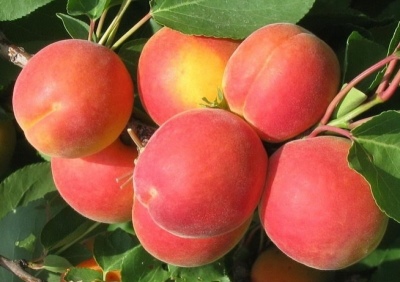
- Authors: I.L. Baikalov and M.N. Matyunin (NIISS named after M.A.Lisavenko)
- Tree height, m: 2-3
- Flowers: large, pink
- Fruit weight, g: 25-30
- Fruit shape: rounded with a small keel
- Fruit color: red, yellow-green in the shady part of the fruit
- Pulp color : light orange
- Pulp (consistency): medium density and juiciness
- Fruit taste: good
- Fruit composition: dry matter 13.7%, sugars 7.1%, acids 1.8%, vitamin C 8.1mg / 100g, pectin 0.57%.
Apricots have long been loved for their beneficial properties, unique taste, light sweetness. The fruit is a real record holder for potassium content, so it will be especially useful for the prevention of cardiovascular diseases. The Northern Lights variety is distinguished by its taste, late ripening, juicy fruits. The main advantage is the ability to land in the northern parts of the country.
Breeding history
This species was bred thanks to the cooperation of the Scientific Research Institute of Horticulture of Siberia and the breeder Baikalov. Was selected among seedlings from free pollination. Initially, the hatching was carried out in Altai, in the mountainous regions, after which it was transferred to Khakassia. Since 2001, he began state variety testing. It is currently considered an elite species.
Description of the variety
Apricot Northern Lights belongs to the late varieties, ripens around mid-August. Blooms in mid-May. The variety is resistant to various fungal diseases. The trees have a rather wide, spreading crown, the leaves are small, elongated, the flowers are large, painted pink. The transportability of the variety is average.
Fruit characteristics
The fruit is large, on average 25-30 g, in the first half of August it has a dark green color. In the second decade, apricot begins to acquire a pink tint first, and then a spectacular red color. The rosy color gives a special nobility to the variety. The stone separates well from the pulp, which has a bright orange hue, medium density and excellent juiciness, contains a fairly large amount of sugar - 7.1%.
Taste qualities
Owners of the Northern Lights apricot note a good, pleasant taste, slight sourness and sufficient sweetness.
Ripening and fruiting
The plant begins to ripen late, in the second half of August. Apricot begins to bear fruit only 4-5 years after planting.

Yield
The species is high-yielding. On average, gardeners harvest 13 to 15 kilograms of ripe fruit. The maximum amount that can be collected from one tree is 47 kg.
Growing regions
This variety can be grown on any soil and in any climate. It is especially popular in the East Siberian region, in the Urals, in the Moscow region, in Altai, as it has high frost resistance and is grown in areas with little snow.
Self-fertility and the need for pollinators
Pollinators are required, since the plant does not have high self-fertility. Such varieties as Abakansky, Sibiryak Baikalova, Khabarovsky can act as pollinators.
Growing and care
For a seedling, you need to choose the highest place in your garden plot, the apricot loves light and warmth, so you need to choose the sunny side. This species is planted in the so-called pitless way. The fact is that the root collar of the tree does not like excessive moisture, if it is in the hole, then all the moisture will remain there. To plant the apricot correctly, you need to make a small mound of about 20-25 centimeters.
In care, this species is unpretentious, requires only moderate watering and timely feeding.



Disease and pest resistance
The Northern Lights variety is resistant to various diseases, including fungal ones. If it is decided to plant a plant in a zone with a temperate climate, then it is necessary to treat it with antifungal agents, since there is a high risk of frequent rains. Pests are reluctant to sit on a tree. The only disadvantage of the variety is its instability to damping off.

Winter hardiness and the need for shelter
The most important advantage of the variety is considered to be good frost resistance. Covering material may not be needed in the central part of the country and in villages where the temperature in winter does not reach 30 degrees. The variety can withstand up to -32 degrees.
If there is a danger for the plant, then it is better to insure yourself and pack in a safe shelter, but this procedure is not mandatory.
Location and soil requirement
Any kind of apricot loves the sun, the Northern Lights variety is no exception. You need to choose the sunniest side, avoiding shady areas. The plant is undemanding to the soil; humus can be used as top dressing, fertilizers. The only requirement is that the earth must be well aerated.
Review overview
Since the Northern Lights variety is popular among gardeners, there are many reviews on the Internet on this topic. Most of the comments are positive. Buyers note high frost resistance, pleasant taste, juiciness of the fruit, rich yield every season.
In general, the buyers were satisfied, since the variety is suitable for almost any weather, it is completely unpretentious in care.































































